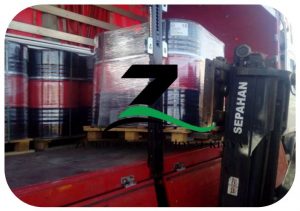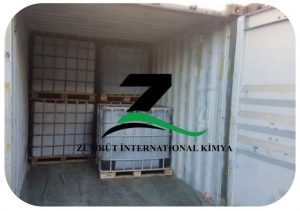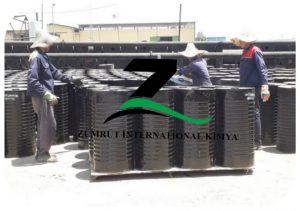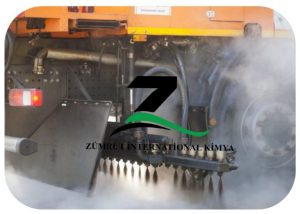
General Definition of Bitumen Emulsion
Bitumen Emulsion is a mixture of fine droplets of bitumen and water. But as the bitumen is a petroleum product it doesn't mix with water and as it is sticky in nature, it doesn't easily gets disintegrated into fine droplets. o overcome this problem an emulsifier is used. Emulsifier can be defined as a surface-active agent.
Bitumen is the oldest known thermoplastic material in use today. Its usefulness and appeal derive from its simple thermoplastic property of being a thin liquid at high temperature and a virtual solid at ambient temperature. For the vast majority of applications, bitumen is used in the temperature range 140 to 230°C at a viscosity of around 200 cSt . For many applications, these conditions are both essential and desirable allowing rapid throughput from hot bulk bitumen delivery through to final use without any reheating. There are limitations to the coating film thickness that can be achieved using hot-applied techniques and for some applications, it is necessary to apply at a lower temperature and/or viscosity.
Bitumen emulsion is heterogeneous, two-phase systems consisting of two immiscible liquids, bitumen and water, stabilized by a third component, the emulsifier. The bitumen is dispersed throughout the continuous aqueous phase in the form of discrete droplets, typically 0.5 to 5 microns in diameter, which are held in suspension by electrostatic charges. Bitumen emulsions can be divided into three classes of which the first two, in volume terms, is by far the most important:
- Cationic emulsions
- Anionic emulsions
- Nonionic emulsions
Use of Bitumen Emulsion
Bitumen Emulsion is used extensively for road construction and maintenance due to the convenience of application, environmental benefits, and cost-effectiveness. It does not require heating like conventional bitumen, hence being safer to use, and it produces fewer toxic fumes. The cold application method allows fast work to proceed without affecting the safety of workers.
One of the key applications of Bitumen Emulsion is road dressing, where it is used as an aggregate binder, improving road life and skid resistance. Bitumen Emulsion is also used in the production of cold mix asphalt, which is particularly handy in areas where there are minimal heating facilities. Bitumen Emulsion also plays a crucial role in prime coating, where it prepares the base for asphalt courses by improving adhesion and waterproofing.
In road maintenance, Asphalt Emulsion finds application in crack sealing, pothole filling, and fog sealing to extend the life of existing pavements. Also, its use in soil stabilization and dust suppression provides for unpaved roads and even construction sites to be kept well-maintained.
The range of Bitumen Emulsion applications extends beyond construction on roads; it is also used in waterproofing, for instance, protecting roofs, basements, and pipelines. Its penetrative ability and capacity to form a durable, water-tight layer make it an appropriate product for building and industrial purposes.
Overall, Bitumen Emulsion offers an environmentally friendly, efficient alternative to traditional Asphalt , providing better working conditions, reducing environmental harm, and making infrastructure last longer.
Related Post
|

Cationic Bitumen Emulsion CSS-1
specially designed water-based Bitumen Emulsion with low viscosity and extended setting time makes it an ideal product for prime coating on highly porous surfaces. It is dark brown in color and is a free-flowing liquid at ambient temperature.
|

Cationic Bitumen Emulsion CSS-1h
Bitumen Emulsion CSS-1h is a slow-setting cationic asphalt emulsion that is designed for various paving and industrial uses.
Asphalt emulsions are classified according to the electric charge that surrounds the emulsion’s asphalt particles
|
|

Anionic Bitumen Emulsion RS-1
Anionic Asphalt Emulsion RS-1 is basically a water-based emulsion in which negatively charged (anionic) bitumen droplets are dispersed in water. This grade is an emulsion for rapid setting and hence it finds its application in surface treatments, such as tack coat and priming.
|

Anionic Bitumen Emulsion RS-2
Anionic Asphalt Emulsion RS-2 is a specialized emulsion with unique properties suitable for various applications. It is classified based on breaking characteristics, with rapid-setting emulsions for surface dressing and medium or slow-setting emulsions for blending with aggregates.
|
Types of Bitumen Emulsion
1- Based on Setting Time :
When the Asphalt emulsion is applied on the aggregate for the road works the water evaporates leaving behind the bitumen droplets. These droplets spread on the aggregate and bind with each other and gains strength eventually. Based upon the time taken by the vitamin emulsion to evaporate the water and between particles to separate from water, Asphalt emulsion is further classified into 3 types based on setting time:
In this type of emulsion, a special type of emulsifier is used to slow the process of water evaporation.
This type of bitumen emulsion doesn't break as when applied on aggregate. The process of evaporation starts when the fine dust of mineral are mixed with the aggregate emulsion mix.
This type of Asphalt emulsion breaks down rapidly as it comes with contact with aggregate helping in fast setting and rapid curing.
2- Based on Surface Charge
Based upon the type of surface charge, they are divided into 2 types:
In anionic Asphalt emulsion, the tiny droplets of bitumen are electronegative recharged. In Cationic bitumen emulsion the tiny droplets of bitumen are electro positively charged. The average and commonly used between emulsions is cationic between emulsions. Selection of positive or negative recharge between emulsions depends upon the mineral composition of aggregate on which it is used Ex: In case of silica rich aggregates the surface of silica is aggregate is positively charged therefore cationic bitumen emulsion is used which helps in better spreading and binding of Asphalt with aggregates.
Advantages of Bitumen Emulsion
- Emulsions can be used in wet weather even if it is raining.
- Is ecofriendly as it is water based.
- This product is also used in soil stabilization in desert areas.
- It doesn't need extra heat while placing.
- There is no wastage in placing and laying of bitumen.
- They possess anti-stripping properties.
- Rapid setting type of emulsion are used in surface of roads.






